#Reduce Smog with Nature
Explore tagged Tumblr posts
Text
Excerpt from this story from Truthout:
We are witnessing a blatant attempt to burn our governmental structure to the ground, destroy any semblance of checks and balances, and allow billionaires and their corporations free rein without consequences.
What does this mean for the Environmental Protection Agency (EPA), which has protected the environment and human health for nearly 55 years, including by regulating air pollution, banning dangerous chemicals like DDT and working to reduce carbon emissions? Trump is revealing the fragility of our government: Progress often takes years of pressure, compromise and monumental amounts of work — consider the recent limits on the dumping of perfluoroalkyl and polyfluoroalkyl substances (PFAS) known as “forever chemicals” submitted by the Biden administration last fall, or the agonizing process of passing the Inflation Reduction Act of 2022. Now, Trump and his right-wing allies are attempting to destroy both with a snap of his fingers.
Speaking days into the Trump presidency — before some of the most horrifying orders came down — Matthew Tejada, senior vice president of environmental health at the nonprofit Natural Resources Defense Council (NRDC), told Truthout that concerns about the future of the EPA can be broken down into three buckets: The White House may seek to roll back or revoke hard-earned environmental regulations and protections, withhold funds that the EPA is charged with disbursing for energy and environmental projects, and weaken the agency by attacking federal employees and the institution itself.
We are already seeing Trump attempt all three avenues of EPA sabotage predicted by Tejada, who previously worked within the EPA’s Office for Environmental Justice and External Civil Rights. Within his first weeks in office, Trump withdrew Biden’s forever chemical reform plan, sought to keep lead in Americans’ drinking water and froze already allocated Inflation Reduction Act funds. Trump has also appointed chemical and oil industry insiders to the agency, fired every scientist on two of the EPA’s most influential science advisory panels and seems poised to attempt mass firings of EPA staff.
The EPA has been under assault before. But in many ways, the threats it faces today are unprecedented.
“EPA has been a punching bag since it was first created,” Tejada told Truthout. The agency was established in 1970 under President Richard Nixon, at a moment when the dangers of pollution were becoming impossible to ignore, from oil spills, to lifeless lakes, to deadly smog and chemical odors permeating cities, to the Cuyahoga River literally catching fire. In 1969, Congress passed the National Environmental Policy Act, which required federal agencies to assess the environmental impact before beginning major projects, and directed the president to assemble the Council on Environmental Quality. The following year, sensing a growing environmental consciousness, Nixon created the EPA.
Over the years, Tejada said the EPA has come to hold a key role in everyday life. “Not that everything has been perfect.… But if you look at the environment that we lived in in 1970, versus today, EPA has been wildly successful at cleaning up the environment in our country.”
“I think a lot of people don’t understand that its ability to have been as successful as it has been, has largely been due to the steady leadership and commitment of the institution and the people who inhabit it,” he continued. “And those people are now under threat in a way that they have never been. If they actually make moves to really gut the staff, to eliminate institutional memory and knowledge? A next president can’t just fix that. You’re talking about generations of value that can pretty quickly be extinguished, and that will take generations to rebuild.”
57 notes
·
View notes
Text






Hey Look At This Comic: The Nib
the kind of essay comics published in The Nib (now sadly defunct) tended to lean towards illustrative panel contents. in a lot of their comics, the images show, basically, what the text describes. it's a way of producing comics that emphasizes clarity of information delivery and tends to have some level of redundancy, with relatively straightforward metaphors. one piece in the "color" issue by Erlend Sandøy bucks that trend in really extravagant fashion. the comic goes against an awful lot of conventional advice about clarity of panel layouts, often choosing sprawling nonlinear layouts or notional strips that run from top to bottom (see the two pages above). the metaphors also come thick and fast, and although most are straightforward there's enough just happening on every page that it enforces a kind of slower exploration of the details.
like, I love the way color (fittingly) and composition work in the fourth page. the smiling bike riders in the bottom catch me, they're discordant with the primary subject of the page--the failure of green parties in coalition to enact their plans and stick to their promises. what's harder to see at a quick glance is the third bike rider who's careened straight into the smog that makes up the frame. it's obscure enough in the print that I totally missed it and put my big dumb fat fingers over it when I was taking the photo! 😩 it's a fun little trick cause it takes the frame, which I think tends even when representational to recede into the background, into another area of panel content. but more than that it brings into sharper focus the overall rhetoric of the page: that green movements have achieved mainly small areas of apparent natural recovery, pushing the deeper structural issues to the margins of discourse. those issues are, however, inescapable.
(I do think the bit about the german greens totally failing to reduce coal power but succeeding in banning nuclear power is quite funny, like gosh do you think those two facts might have some causal relationship? ha ha oops)
the sprawling nonlinearity is also really well suited to a page like the overview of the countries where green parties hold power, which IS a sprawling, informationally non-hierarchical subject. how the reader navigates this page doesn't matter, and it's nice to see someone breaking from the McCloudian/Eisnerian focus on the sequence as be all end all. more than that, though, I just think it's clever and charming! What a good looking gosh darned page! composing the globe out of foliage and having pop-out informational panels be branches with their own leaves? it's great stuff, a pretty immediately graspable visual device that's both pertinent and super flexible. there's all these interesting little details--like look at the ballots flowing out of the US like leaves stuffing that ballot box, juxtaposed with the text pointing out that first past the post means all these votes go, essentially, into the void. the image doesn't make that last bit clear, and the text doesn't spell out the leaf metaphor, it's a gestalt. that's comix, baby! awoo!
the whole coverage within this comic in particular feels like a very even handed account of the green political movement's achievements and also some of its ideological failures--again, often conveyed not directly through fairly neutral text but instantiated in the art itself. it's just one of a number of comics in this issue that feel bold and experimental, and when I first wrote this review in 2023 I suggested picking up a copy of the Color Issue. in fact, it looks like you still can--I guess that must be one issue that remains in stock. but The Nib itself is no more and most of its issues, including gems of experimental documentary comicking like this, are out of print. thankfully, on the way out founder Matt Bors decided to put the entire collection onto the Internet Archive. you can read the color issue there.
this review originally ran on Cohost, Thu, Feb 23, 2023. I am porting these reviews with minor editing over to Tumblr and eventually to my own website, because websites and periodicals may die, but comics are forever.
41 notes
·
View notes
Text
Phyrexian (Template)

(Spire Drake by Daniel Ljunggren)
(Consider this the sister to the Compleated race; a template that lets you fill out different phyrexian roles as needed without having to come up with wholecloth creations. That said, it's also definitely a crucial part of New Phyrexia's feel, corrupting existing creatures and turning them into more deadly versions of themselves.)
Phyrexia's ultimate goal is conversion, for all life in the universe to experience the glorious perfection of the machine. Phyrexian creatures are living examples, steps towards universal compleation.
Phyrexians have a twisted fondness for drakes, due to their combination of power, flight, and fecundity; they are often assigned as guards, a duty to which they may chafe.
Creating a Phyrexian Creature
“Phyrexian” is an acquired template that can be applied to any living creature.
Type: Type changes to Aberration (Phyrexian). Do not recalculate BAB, skills, or saves. Ability Scores: +4 Str, +2 Int, -2 Wis. Alignment: Alignment changes to NE Natural Weapons: If a creature has no natural weapons, it gains two claw attacks as appropriate for its size. Its claws, or its bite attack if it has no claws, gain the Phyresis disease quality. Natural Armor: The creature gains a +2 bonus to natural armor. Disease: Phyresis, Type: Disease, Wound Save: 10+½ the creature’s HD+the creature’s Con modifier Onset: 1 Day Effect: 1d4 Wis damage, victim is sickened. When the victim's Wisdom is reduced to zero this way, restore all damage, and the creature gains the Phyrexian template. Additionally, caster level checks to cure phyresis get +4 to their DC. Cure: 2 consecutive saves. Defenses: Gains immunity to disease, poison, and acid, and negative energy affinity. Languages: Learns Necril CR: +1 Phyrexian Gift: A phyrexian creature gains one of the following traits chosen at the time of its creation; Ferocity- This creature gains the ferocity Universal Monster Rule. Long Claws (Ex)- This creature’s claws grow long and precise; their claw natural attack has a x3 critical modifier. Many Eyes (Ex)- This creature is given eyes scattered all across its face; it gains the all-around vision sense. Masked (Su)- This creature’s eyes are covered by a mask that is part of its body; it becomes blind, and gains blindsight 60ft. Smog (Ex)- This creature’s body is constantly producing an area of smoke in the space the creature, providing partial concealment (20% miss chance) to the creature and any creatures sharing its space. This smoke can be blown away with a Gust of Wind or similar strong wings, though it returns 1d4 rounds after the wind dissipates. Swampwalker (Ex)- This creature may ignore natural difficult terrain in swamps, such as undergrowth, bogs, and mud.
Phyrexian Sea Drake
A drake flies by, its wings slick with oil, its chest seemingly skeletal, and its face dotted with eyes.
Misc- CR7 NE Large Aberration (Phyrexian, Augmented Dragon) HD7 Init:+6 Senses: Perception:+10, Darkvision 60ft, All-Around Vision Aura: Stats- Str:27(+8) Dex:15(+2) Con:18(+4) Int:10(+5) Wis:8(-1) Cha:9(-1) BAB:+7/+2 Space:10ft Reach:10ft Defense- HP:73 (7d12+28) AC:21 (+2 Dex, +10 Natural, -1 Size) Fort:+9 Ref:+9 Will:+4 CMD:27 Immunity: Electricity, Acid, Paralysis, Sleep, Poison, Disease Weakness: Special Defenses: Negative Energy Affinity Offense- Bite +14(1d8+6 plus 1d6 Electricity and Phyresis), Tail Slap +9(1d8+3) CMB: Speed: 20 ft, fly 60 ft (average), swim 60 ft Special Attacks: Ball Lightning Breath, Capsize Feats- Improved Initiative, Lightning Reflexes, Power Attack, Skill Focus (Stealth) Skills- Fly +10, Intimidate +9, Perception +10, Stealth +11, Swim +24 Special Qualities- Amphibious, Speed Surge, Phyrexian Gift (Many Eyes) Ecology- Environment- Any Coastline Languages- Necril, Draconic Organization- Treasure- Standard Special Abilities- Ball Lightning Storm (Su)- A sea drake can, as a standard action, breathe a ball of electricity that strikes one target first, then arcs to other targets like chain lightning. This attack has a range of 100 feet, and deals 6d6 points of electricity damage (DC 17 Reflex half) to the primary target. After it strikes, the ball lightning can arc to a number of secondary targets equal to the sea drake's Hit Dice (usually 7) within 20 feet of the primary target. The secondary bolts each strike one target and deal as much damage as the primary bolt. Once a sea drake has used its ball lightning breath, it cannot do so again for 1d6 rounds. The Reflex save is Constitution-based. Disease (Ex)- Phyresis, Type: Disease, Wound Save: 17 Onset: 1 Day Effect: 1d4 Wis damage, victim is sickened. When the victim's Wisdom is reduced to zero this way, restore all damage, and the creature gains the Phyrexian template. Additionally, caster level checks to cure phyresis get +4 to their DC. Cure: 2 consecutive saves. Speed Surge (Ex)- Three times per day as a swift action, a sea drake may draw on its draconic heritage for a boost of strength and speed to take an additional move action in that round.
34 notes
·
View notes
Text
David Zipper at Vox:
Despite a recent slowdown in US sales, global forecasts for electric vehicles remain bullish. Countries across North America, Europe, and Asia are expanding charger networks and offering EV subsidies; global EV sales are projected to nearly triple by 2030, reaching 40 million vehicles annually. The incipient wave of EV purchases raises a question: What will happen to the millions of gas-powered cars whose owners no longer want them? The likely answer: Rather than scrapping used gas vehicles or selling them domestically, rich nations will dispatch them to developing countries where limited incomes and low levels of car ownership have created eager buyers for even older, substandard models.
An influx of used gas cars would be a welcome development for those in the Global South who aspire to automobile ownership, a luxury that many in affluent countries take for granted. But it would undermine efforts to mitigate climate change, since shifting gas guzzlers from one country to another doesn’t lower global emissions. For developing countries themselves, a sharp increase in car ownership could amplify calls to build auto-reliant infrastructure, making it harder to construct the dense neighborhoods and transit networks that can foster more sustainable growth. And since these imported used cars would be fueled by gasoline, air quality would further decline in cities that are already choked with smog. The world is in an era of polycrisis, facing concurrent challenges including climate change, toxic air, and extreme inequality. Difficult trade-offs are often inevitable. Such is the case with the thorny issue of what to do with the millions of gas cars that the rich world will discard as its fleets are electrified. Electrification is a necessary goal. And it’s natural for people in the developing world to desire the same luxuries that characterize middle-class comfort in wealthier countries. The question is how to manage a transition with enormous stakes that has largely been ignored. The experts who do pay attention are growing alarmed.
[...]
How used cars move from rich nations to poor ones
Although it generates few headlines, a massive industry transports used cars across borders every day, with exporters collecting lower-quality models from dealers and wholesale auctions. Ayetor noted that colonial legacies are reflected in the trade flows: the UK, with its car cabins designed for drivers who keep to the left, tends to ship to former colonies like Kenya and Tanzania that still follow the same rules.
According to a report issued in June by the United Nations Environment Programme (UNEP), some 3.1 million used cars were exported in 2022, up from 2.4 million in 2015. Most come from Japan, Europe, and the United States. (In the US, around 7 percent of all cars no longer in use are sent abroad. The rest end up in junkyards where their parts and materiel are sold off.) About one in three exported used vehicles is destined for Africa, followed by Eastern Europe, Asia, the Middle East, and Latin America. Imported models often dominate local auto sales, since international carmakers send few new vehicles to the Global South and rarely establish production facilities there. (In sub-Saharan Africa, only South Africa has local factories.) The developing world’s demand for cars is robust, in large part because comparatively few people own one. According to one 2020 estimate, the US had 860 cars for every 1,000 residents, while South Africa had 176, Morocco 112, and Nigeria just 56. Meanwhile, growing populations provide a steady supply of new potential customers. Africa is home to all of the world’s 20 fastest-growing countries, with Angola, Democratic Republic of the Congo, Niger, and Uganda expanding their populations by at least 3 percent per year. (For comparison, the US population is growing at a 0.67 percent rate).
[...]
The world needs a plan to adapt
The risks of aged, polluting cars sent abroad will not be borne by the Global South alone. Climate change is a planetary phenomenon; driving a gas guzzler produces the same amount of emissions in Lusaka as it would in London or Los Angeles. Reducing greenhouse gasses requires reducing total vehicle emissions, not just shifting their location. In an ideal world, electrification would enable the rich world to scrap its most decrepit gas cars. Instead, wealthy nations are likely to ship them to poorer countries, which will be left to figure out what to do when even the most MacGyver-like mechanics cannot keep them running. “All of your worst vehicles end up here,” Ayetor said. “When we want to get rid of the vehicle, what do we do?” No wealthy nations currently screen exported vehicles to weed out those that flunk basic quality tests, Kopf said. But that may soon change. The European Union is now considering new regulations that would prohibit exporting “end of life” vehicles, requiring that cars shipped abroad obtain a certificate confirming their roadworthiness. Its adoption would be a “game-changer,” according to UNEP’s Akumu. (She and Kopf said they know of no comparable proposals under consideration in North America.)
With the increase of electric vehicles in the developed countries, used gas-fueled cars are headed to a developing country (aka the Global South) at increasing rates.
5 notes
·
View notes
Note
' it's quite funny how the world works. suddenly, killing makes you a villain if you're not some high end fancy pants ordering men to die in the name of honour. a flag is a stupid think to waste your life over, but, it's made glorious and beautiful and honourable. nobody tells you about the rage that comes with it, with the understanding that war is man-made violence and, therefore, it isn't a part of the natural cycle of life and death. '
bunny mask's first thought when the other first began speaking that the other had a very powerful way of commanding her attention; a trait that bunny mask herself found interesting, for this meant whoever possessed it oozed confidence, in her opinion. and although the spirit herself would willingly listen to anyone given the chance, it made her wonder about who this woman beside her was already. or what all she had experienced, as it were, since life events seemed to often have a tendency to shape who you are. bunny mask was clad in her usual attire at the moment; her mask in the shape of a rabbit obscuring the upper part of her face completely, with only wide slits cut out of it near the top to accommodate her glaring white eyes, and the dress she wore a nearly pristine looking white color.
and i say nearly because of the soot that was smeared across her collar. however, she thought she knew what she was getting into whenever she followed the sight of smoke in the distance, so this was of little importance to her: what was important to bunny mask was seeing if anyone needed her help here. it was usually a bad sign whenever a deep, dark smog that screamed ' fire ' had created a wall of it's own in the sky. but it turned out that she was wrong. this place was clearly pillaged and completely torn apart brick from brick, as the places that people used to call home were reduced to piles of wood scorched by embers. a thick layer of ash seemed to have formed in the midst of the landscape, and bunny mask could feel in her gut that something terrible had happened here.
perhaps as part of a war, as mya highlighted. the spirit could feel her heart drop while the other described her perspective on the sometimes militaristic and bleak nature of humanity. no, was it her experience? bunny mask thought that the way she phrased her words made this all sound very personal. a frown tugged at her lips as she bent down to touch the ash, letting it run through her fingers. mya was right — this was nothing to be proud of. she looked up at the other from the side, then, and spoke, ❝ you are right. i sincerely hope you were not here to witness what had happened here, for that would be a horror that you would likely never forget. but the men who do things like this, who ordered their own to risk their lives to ruin other's; they simply refuse to think they are the villains of anyone's story because they believe they are doing it for a noble purpose. though they are certainly not. ❞
bunny mask stood up and took a deep breath as she surveyed the land before her. there looked to be no survivors here, so the people here were either all killed, or maybe some had escaped. the latter might've been wishful thinking but bunny mask wanted to have some hope that this place was not turned completely into a mass grave, ❝ was that what this conflict was born from? the excessive pride of a nation, who are of the mind that they're righteous and good, but commit barbaric acts such as this one? ❞ she had to tell herself to take a deep breath now or she would likely lose herself to anger. and that would not be a pretty sight, for neither her, nor the other who stood just an arm's length away from her. in and out. bunny mask could feel the claws of her right hand dig into her palm as she took a moment to inhale, then exhale, but she didn't care.
everything about this was wrong. bunny mask let her eyes become half-lidded with the sense of sorrow that had come over her suddenly, like a tidal wave. it was just as she feared. mya had experienced this for herself, ❝ it is not natural. that, i must agree with. i am of the belief that we are fated to leave this world at a specific time and the lives of the humans that died in this town were stolen. they still had much to experience, to love. and from what i am hearing, you were forced to partake in the wrongful robbing of people's lives yourself, were you not? through war. an organized form of slaughter, glamorized to appear necessary by the masses, where there is no true victor. where everyone loses something and you are left feeling full of rage because of what you were coerced to do. ❞
the chill running through bunny mask's bones only intensified when she saw it on the ground. a doll, abandoned by it's owner, within the ash. bunny mask's voice became low, ❝ i am sorry. i am... so sorry. ❞
#furiaei#tw: mentions of a fire.#tw: war.#tw: allusions to a child's death.#i'm sorry for making this super sad near the end... but i felt like it was needed for such a heavy topic. when it comes to things like war-#that are so terrible in nature you kind of have to include little things to emphasize the horror of it.#but i hope you liked my response anyhow. i tried really hard to further the really good and i think important point you were making-#regarding war and the people who get swept up in the midst of it.
7 notes
·
View notes
Text

Smoke Fills South American Skies
Intense fires burning in several South American countries draped large swaths of smoke across the continent throughout August and early September 2024. In Brazil and Bolivia, fire activity reached levels not seen since 2010 as a prolonged drought parched landscapes in both countries.
From about 1 million miles (1.6 million kilometers) away from Earth, NASA’s EPIC (Earth Polychromatic Imaging Camera) imager on the DSCOVR (Deep Space Climate Observatory) satellite captured this view of smoke billowing from the blazes on September 3, 2024.
Smoke from fires in Brazil swept over the country’s capital city in mid-August and early September. For several days, São Paolo’s air was clouded with smog, and air quality was unhealthy for sensitive groups, according to AirNow. The smoke grounded flights and forced schools to close in the most populous city in Brazil, according to The Guardian.
The fire season in the southern Amazon, which generally ramps up in August and peaks in September and October, has been intense this year. According to the Copernicus Atmosphere Monitoring Service (CAMS), a component of the European Union’s space program, emissions from fires have been exceptionally high in Bolivia and the Brazilian states of Amazonas and Mato Grosso do Sul.
CAMS estimates near-real-time wildfire emissions using its Global Fire Assimilation System (GFAS), which aggregates observations made by the MODIS (Moderate Resolution Imaging Spectroradiometer) sensors on NASA’s Aqua and Terra satellites. Compared to the previous 21 years, these areas have registered their highest year-to-date total emissions, at 44, 22, and 13 million metric tons of carbon, respectively.
The Pantanal region—which straddles the Brazil-Bolivia border and is home to one of the world’s largest tropical wetlands—has been especially hard hit in 2024. Early and intense blazes spread over the wetlands in late May and continued into August. According to Brazil’s National Institute for Space Research (INPE), there were a record number of fire detections in the biome in June 2024, and fires have continued to burn at high levels since.

The false-color image above, acquired by the OLI (Operational Land Imager) on Landsat 8, shows fires near Ascensión de Guarayos, in the Bolivian state of Santa Cruz. The false-color image emphasizes the burn areas (brown) from several fires on September 3, 2024. Unburned vegetation is green. Near- and short-wave infrared bands help penetrate some of the smoke to reveal hot areas associated with active fires, which appear orange.
Through September 6, blazes tore through more than 10 million hectares of Bolivia, or roughly 9 percent of the country’s total area. Out of the 42 million metric tons of carbon emitted in Bolivia between May and August, 33 million metric tons came from fires in the state of Santa Cruz, according to Mark Parrington, CAMS senior scientist with the European Centre for Medium-Range Weather Forecasts (ECMWF).
Large parts of South America have seen significant rainfall deficits over the past three months. According to ECMWF, this has led to “exceptional drought” (the highest drought ranking) over much of the central and northern parts of the continent. Brazil’s Natural Disaster Monitoring and Alerts Center noted on September 5 that shifted rainfall patterns from El Niño, increased temperatures from climate change, and reduced humidity from deforestation have all contributed to the drought.
NASA Earth Observatory images by Michala Garrison, using data from DSCOVR EPIC and Landsat data from the U.S. Geological Survey. Story by Emily Cassidy.
2 notes
·
View notes
Text
West Quebec: 4 national parks north of Montreal & Quebec City
When I had checked in at national park Hautes Gorges, they already told me that most of the park including the river activities and most hiking trails were closed due to the high rain fall a few days earlier, but when I woke up the forest fire smoke had moved in as well; double whammy of climate change impacting my travel! 🥺
On top of it I felt crap from a cold that I had developed the day before (am thinking I got the virus on one of the boat tours when everybody was on top of each other to take pictures) so I took it extra slow in the morning, already cooking the rice for the evening meal (staving off a brazen chipmunk who kept jumping on the table) and even doing an old-fashioned steam session with vix under a towel to loosen it all up. 😂
From the visitor centre, I did end up doing a 8.4k hike, first up to a boring lake (undoubtedly made more unattractive by the smog) which was higher than I thought so was struggling to breathe in between my coughs and sneezes, and then along the river which was indeed raging; it would have been impossible to SUP let alone swim in the water! I then took the shuttle bus to a little dam where the water flow continued to be impressive so had some snacks at a picknick table while doing a crossword. Not feeling great at all, I skipped dinner & went straight into the tent at 6pm... not the best of days! 🤧

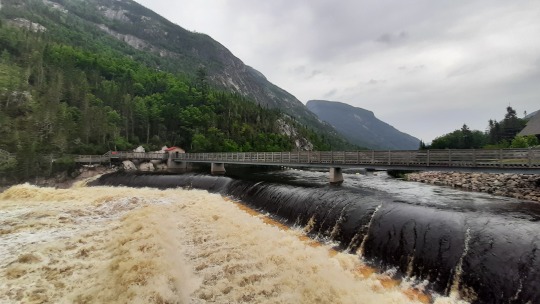
It was good that I had gone to bed so early as it meant that I had a few hours of sleep before a thunderstorm rolled in. I always find it a bit scary to stay in the tent but not sure the car is much better... the tent and I survived 🙃 but it meant that once more everything was damp/wet/soaked when packing up, truly the main downside of camping!
On my way to the next campground, I spent the day at Grands-Jardins national park, which was also impacted by the floods but luckily the "jewel" hike up Mont du Lac des Cygnes was open. At 8.6k and 500m elevation gain, the hike was not the easiest but my sneezing had already been much reduced (although I'm still coughing a week later) so I felt reasonably well. After the first viewpoint at a pretty lake (confusingly not the Cygnes 😜) the last km was a scramble up rocks and staircases, but then an incredible view opened up of the surrounding hills and valleys, all part of another massive astrobleme (this time the 11th largest of the world) when a meteorite hit the earth a long time ago. Beautiful! 🤩


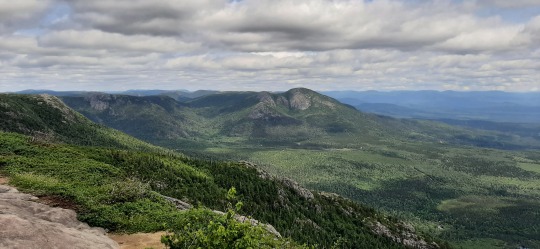


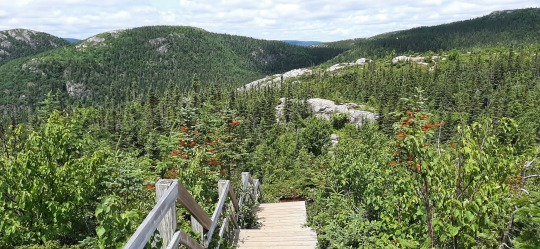

Driving at the end of the afternoon towards Québec City, the rolling hills which were very pretty to drive through all the way from Baie-Comeau, made way for the flat plains around the river while in the distance the city contours with its chateau became visible... before I reached the "capital nationale" 😄 however, I veered north to a private campground close to park Jacques-Cartier. Generally, I prefer to stay in park campgrounds rather than in private ones, as they're more natural, cheaper and have better showers 😅, but this one was actually really good; it had a lot of space, amenities such as a fastfood truck, mini golf and a (now not so lazy) river where people floated on inflatables, and most importantly, a truly quiet nighttime!
Again, most of the park was closed as a result of flooding, so I did a lovely 4k hike around a cascading river (am feeling much better now!), and then felt incredibly lazy so hung the rest of the day at the visitor centre talking to my parents, writing the blog and putting my feet up! 😊😊I did start another small hike on the way back but aborted after 10 minutes, simply not feeling it 😝. In the evening, I had two trip firsts; I used a standalone rack to cook over the fire (private campgrounds don't provide a grill where park ones do), and I finally made my first s'more, with a kitkat as the camp store didn't have any real chocolate 😅. Very satisfying!!

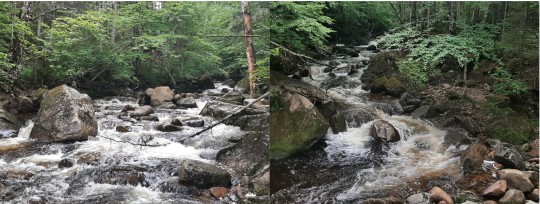


Rain had been forecast for the next day however it was still dry when I woke up, so I swiftly cleaned up camp and did a 6.6k hike up a mountain. The view was not as great as I had thought it would be, but not complaining though, always a 100x better than a computer screen! 😉 The rain did start when I got to the top and quickly turned into a downpour, so had to do a complete change of clothes on my return at the visitor centre 😂... once I'm fully soaked I don't mind the wetness anymore, as long as I know I can dry & warm up at the end of it!

Not being in a particular rush to get to my next campsite in the pouring rain, I spent a few hours in Quebec's largest mall, the Galeries de la Capitale, buying some things and having chinese at the foodcourt! 👌 I'm not a big fan of malls, but this one was quite impressive with an indoor skating rink, a ferris wheel, rollercoaster and carrousel - although you can imagine the noise was ear deafening and a bit of a shock to the system after camping.
When I got to La Mauricie national park, the sun had come out again so spent a leisurely evening at the campfire, more my cup of tea than the busy mall! The next day started humid and cloudy, so I forewent another steep uphill hike for a series of shorter ones along the 50km park way. Driving from one end of the park to the other side, there's little hikes at lakes, bogs, viewpoints that are all equally pretty and don't require much effort, so perfect to drink my cup of tea while taking in the scenery! At the west end, people were swimming in the rapids, but instead I took a refreshing dip in the lake & then chilled on the beach for a while.
I won't post too many pictures of my campfires, but this one I was particularly proud of as it had been a struggle in the last days to get it going due to the wood being wet... very frustrating when the fire keeps fizzling out but now I heaped so much kindling on it that the strong heat dried up the logs quickly.
After 6 days of camping, I'm ready to get back to town and check into a hotel in Montreal and then off to northwest Ontario!
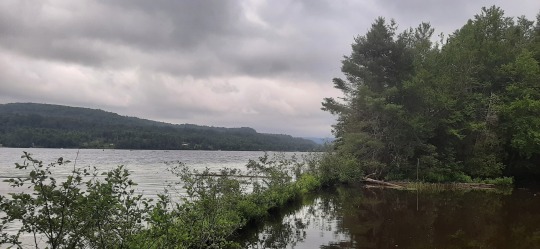


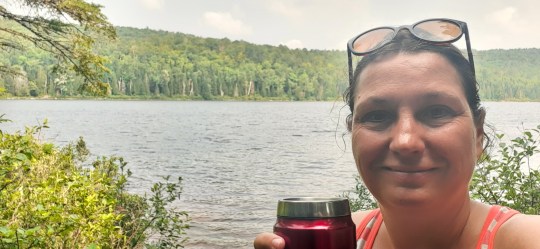

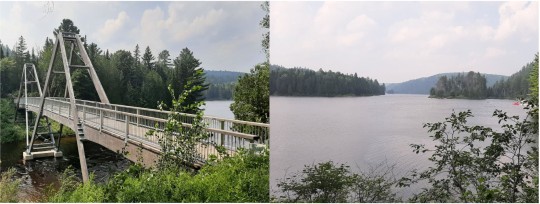


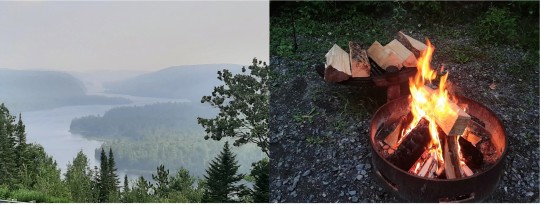
Wildlife: 1 porcupine (Hautes Gorges), 1 heron, tens of tiny frogs, 1 turkey & 1 deer (La Mauricie)
SUPs: none
Hikes: one at Hautes Gorges, one at Grands-Jardins, two at Jacques-Cartier, 5 little ones at La Mauricie
2 notes
·
View notes
Text
despite most buses requiring the use of diesel, for the last 10 or so years the standard manufacture for the fuel systems includes DEF, or Diesel Emissions Fluid. DEF is literally just a specific concentration of urea in distilled water. It reduces fossil fuel emissions from diesel engines to so much lower than even gas cars. Many public transit buses use natural gas for the same reason - it literally visibly reduces smog from cities. Since schoolbuses run the same route, have standardized repair and parts, their own and specialist mechanics and drivers, schoolbuses are by FAR far much more efficient over the course of their working life compared to the same amount of consumer vehicles that would be needed to do the same amount of transport. By driving the same route, the fuel efficiency and emissions are reduced by having just ONE passenger - children can't drive themselves and their parents would drive the same distance twice a day to get their kids to school. In rural areas, the total benefit skyrockets ASTRONOMICALLY in terms of time/fuel/emissions/road wear spent moving people around across gravel roads and inclement conditions. Schoolbuses are built with their own roll cage as a skeleton to the whole vehicle — the US Department of Transportation considers schoolbuses the safest vehicle on the road for this reason alone, although many, many other safety considerations exist in the design of your average Big Yellow Bus.
I've been a schoolbus driver in a suburban/rural area for about 2 years. I have more to share but in sum, be grateful every time you see a schoolbus that things in the world are an appreciable amount better for them being there. Also please always always always stop when they have their stop signs out.

A bus may have only a couple of passengers, especially at the beginning or end of its route. But let's also take fuel efficiency into account.
104K notes
·
View notes
Text
Nature Meets Protection: How Sustainable Wood Sealers Preserve More Than Just Wood
Wood has been a vital building material for centuries, offering beauty, strength, and a natural connection to the environment. However, to maintain its durability and charm, it requires protection—especially when exposed to the elements. This is where a wood sealer comes in. But not all sealers are created equal. Today, more homeowners, builders, and designers are turning toward sustainable wood sealers that not only protect the wood but also safeguard the planet.

Understanding the Role of a Wood Sealer
Before diving into sustainability, it's important to understand what a wood sealer actually does. A wood sealer is a protective layer applied to wood surfaces to shield them from moisture, UV rays, mold, and decay. Whether it’s indoor furniture or outdoor decks, sealing wood extends its lifespan and helps retain its appearance.
Traditional sealers often contain harsh chemicals and solvents that, while effective, pose risks to the environment and human health. That’s where the need for green wood sealers arises—products designed to offer protection without the environmental cost.
What Makes a Wood Sealer “Sustainable”?
A sustainable wood sealer is typically made from eco-friendly, biodegradable, or low-toxicity materials. These sealers avoid the use of harmful volatile organic compounds (VOCs) that can pollute indoor air and contribute to smog formation. Here's what sets sustainable sealers apart:
Low or zero VOCs: Reducing harmful emissions for cleaner air.
Biodegradable ingredients: Breaking down naturally without harming the environment.
Renewable sources: Using plant-based oils or water-based formulas instead of petroleum-based chemicals.
Recyclable packaging: Less plastic waste in the long run.
Choosing such sealers means taking a stand for the environment while still providing strong, reliable protection to wood surfaces.
Benefits Beyond the Wood
Using a green wood sealer does more than just preserve wood. It creates a ripple effect that benefits your health, home, and the planet:
1. Healthier Living Spaces
Traditional sealers can release fumes and toxins into the air, especially indoors. This can lead to headaches, respiratory issues, or allergic reactions. In contrast, sustainable wood sealers are often non-toxic and safer for children, pets, and anyone sensitive to chemicals.
2. Improved Indoor Air Quality
Low-VOC sealers help maintain better air quality inside your home. This is especially important in modern, energy-efficient homes that are tightly sealed and have less natural airflow.
3. Environmentally Responsible
Every small eco-friendly choice matters. When you opt for a sustainable product, you’re reducing the pollution and waste that might come from synthetic chemicals and plastic-heavy packaging.
4. Long-lasting Results
Many people assume eco-friendly products are less effective—but that’s a myth. A high-quality green wood sealer can provide the same level of protection and durability as traditional options, often with better resistance to mold and water damage.
5. Enhanced Aesthetics
Natural or water-based sealers allow the wood’s texture and grain to shine through, enhancing its natural beauty instead of masking it.
Practical Uses of Sustainable Wood Sealers
Whether you’re working on a DIY backyard project or renovating indoor wood floors, a sustainable sealer fits in perfectly. Some common uses include:
Outdoor decks and patios
Wooden fences and garden furniture
Indoor wooden floors and cabinets
Decorative wooden walls or beams
Because of their safe and natural composition, they’re ideal for any space where sustainability and indoor air quality are top priorities.
Small Steps, Big Impact
Adopting sustainable building practices doesn’t require a total lifestyle change. Small shifts—like choosing a green wood sealer—can have a big positive impact over time. When many individuals make these eco-conscious choices, they collectively contribute to a healthier environment.
Preserving Beauty While Protecting the Planet
Conclusion

In today’s eco-aware world, it’s not enough to just protect wood—we must also protect what surrounds it. A sustainable wood sealer bridges this gap beautifully, offering all the benefits of traditional sealers while respecting nature. By making this thoughtful switch, you’re not only extending the life of your wood but also promoting a healthier home and a greener planet. So the next time you reach for a wood sealer, remember: nature meets protection best when sustainability leads the way.
0 notes
Text
Face Washes for Glowing and Healthy Skin: Your Daily Skincare Essential Face washes are the foundation of every effective skincare routine, helping to keep your skin clean, refreshed, and free from impurities. A good face wash not only cleanses but also addresses specific skin concerns like acne, pigmentation, and premature aging. BellaCast provides two outstanding choices: the Vitamin C Face Wash and the Age Revival Face Wash. Both are made with natural, scientifically supported components to work on all skin types and improve the health and brightness of your skin. Using the right face wash is crucial because facial skin is constantly exposed to dust, pollutants, sweat, and oil. According to a study published in the Journal of Clinical and Aesthetic Dermatology, daily facial cleansing helps remove sebum, dead skin cells, and environmental toxins that can clog pores and trigger breakouts or premature aging. Face Washes for Different Skin Needs BellaCast Age Revival Face Wash: For Skin That Is Younger and More Vital BellaCast Age Revival Face Wash is designed to rejuvenate and refresh aging skin by targeting signs like wrinkles, dark spots, and fine lines. Natural compounds that are added to it gently cleanse the skin without dehydrating it. The formula helps reduce excess oil, acne, and pigmentation while promoting a radiant glow. BellaCast vitamin C face wash: For Brightening Skin Tone
BellaCast Vitamin C Face Wash is thoughtfully formulated to be gentle on facial skin while providing effective protection against environmental stressors like pollution and harsh sunlight. Enriched with natural and potent ingredients, this Vitamin C face wash helps brighten the complexion, reduce dullness, and promote clear, radiant, and healthy-looking skin. BellaCast Choco facewash: For natural & Soft Scrubbing Experience the nourishing care of BellaCast Choco Face Wash, specially designed to reduce dark spots, scars, and skin discoloration. This gentle yet effective cleanser removes dead skin cells, impurities, and environmental pollutants like dirt and smog, leaving your skin feeling fresh and renewed. Enriched with the goodness of chocolate, it supports the skin’s natural regeneration process and helps slow down visible signs of aging. With regular use, it promotes a smoother, clearer complexion while its rich, chocolaty aroma adds a touch of indulgence to your daily skincare routine. Science Behind the Ingredients BelllaCast age revival facewash:
Bilberry Extract: Known for its antioxidant properties, bilberry helps reduce inflammation and slows the breakdown of collagen, thus reducing signs of aging. Blue Lotus Flower Water: A natural hydrator and skin soother, blue lotus has calming effects that are ideal for mature or irritated skin. Aloe Vera Extract: As shown in the Indian Journal of Dermatology, aloe vera hydrates and heals the skin, making it an effective anti-aging and anti-acne agent. Orange & Lemon Fruit Extracts: Natural sources of Vitamin C, they brighten the skin, fade pigmentation, and provide antibacterial protection. Sandalwood Oil: Known in Ayurveda for its anti-inflammatory and antiseptic properties, it helps in calming the skin and reducing blemishes. Vitamin C facewash :
Vitamin C : One of the most powerful antioxidants for skin, Vitamin C helps inhibit melanin production, which reduces dark spots and evens out skin tone. Research in Nutrients journal supports its ability to repair sun damage and boost collagen. Seabuckthorn: Rich in omega fatty acids and vitamins, seabuckthorn enhances skin elasticity and accelerates healing. Orange Peel & Lemon Oil: Packed with Vitamin C and citric acid, they cleanse, detoxify, and reduce acne-causing bacteria. Aloe Vera Extract: Provides hydration, reduces redness, and boosts skin repair.
Choco facewash: Chocolate : chocolate is rich in antioxidants like flavonoids and polyphenols, which help protect the skin from free radical damage caused by pollution and UV rays. It also improves blood circulation, hydrates the skin, and supports collagen production—making the skin appear smoother and more youthful.
Walnut Shell: walnut shell is a natural exfoliant made from finely ground walnut shells. It gently removes dead skin cells, unclogs pores, and stimulates skin renewal without using harsh chemicals, leaving the skin polished and refreshed.
Benefits: Age revival facewash: This face wash offers a deep cleansing action that unclogs pores and removes built-up dirt and oil, helping your skin breathe freely. It effectively targets common skin concerns like pimples, dark spots, and early signs of aging such as wrinkles. By combating tanning and reducing pigmentation, it helps restore your skin’s natural tone and clarity. With regular use, it revitalizes dull, tired-looking skin and brings out a fresh, healthy glow. Its balanced formula is especially suited for oily and combination skin, making it a great choice for everyday skincare.
Vitamin C facewash: This gentle yet effective face wash works wonders for the skin by reducing pigmentation and repairing sun damage caused by daily exposure. With regular use, it helps fade blemishes and pimples, leaving the skin clearer and more even-toned. It also brightens dull skin and restores a natural, healthy glow. The formula smooths out fine lines and improves overall skin texture, giving your face a refreshed and youthful look. Made with skin-friendly ingredients, it is suitable for all skin types and perfect for everyday use. Choco facewash: This face wash helps reveal smoother, softer facial skin by gently cleansing and refining the texture. It works to even out skin tone while targeting dark spots and acne, helping to clear up blemishes over time. The formula also rejuvenates dull, tired-looking skin, bringing back its natural vitality. With soothing ingredients, it calms dry and irritated areas while effectively removing excess oil, leaving the skin feeling balanced, refreshed, and healthy after every wash. How to Use for Best Results By applying a tiny bit of the Age Revival Face Wash, gently massage the face in circular motions while it is still wet. For best results, use twice a day, in the morning and at night. Face Washes Enriched with Vitamin C – Brighten and Protect BellaCast Vitamin C Face Wash is formulated to defend your skin against environmental damage caused by pollution and sun exposure. With potent ingredients like orange peel, lemon oil, and seabuckthorn, it helps lighten pigmentation, fade blemishes, and restore a healthy, youthful glow. Face Washes ��� A Vital Step Toward Clear, Youthful Skin Choosing the right face washes for your skin can make a visible difference in texture, tone, and overall appearance. BellaCast Age Revival Face Wash and Vitamin C Face Wash are both designed to meet specific skin needs while being gentle and effective. With regular use, they not only cleanse but also nourish and repair your skin, helping you achieve a naturally radiant complexion. Conclusion: Face Washes That Nourish, Cleanse, and Protect In conclusion, using face washes like BellaCast Age Revival Face Wash, Vitamin C Face Wash & choco facewash is one of the simplest yet most effective steps you can take for better skin health. Backed by natural ingredients and supported by research, these formulations go beyond basic cleansing—they rejuvenate, brighten, and protect your skin every day. Whether you're dealing with early signs of aging or want a brighter, blemish-free complexion, these face washes offer a safe, natural, and reliable solution for all skin types.
1 note
·
View note
Text
Climate Change and Air Quality: The Role of STEM in Building a Sustainable Future

A groundbreaking study from MIT reveals that climate change will make it harder to reduce ground-level ozone, a major component of smog, in some regions like Eastern North America and Western Europe. As global temperatures rise, the effectiveness of current pollution control strategies, such as reducing nitrogen oxide emissions, will diminish. This means we’ll need even steeper emission cuts to protect air quality and public health.
Ground-level ozone is a harmful pollutant linked to respiratory diseases, heart problems, and thousands of premature deaths each year. Controlling it is complex because it forms through chemical reactions influenced by sunlight, temperature, and emissions of nitrogen oxides and volatile organic compounds.
How STEM Helps Us Tackle This Challenge:
🔹Advanced Climate & Chemistry Modeling: Researchers combined climate simulations with atmospheric chemistry models to predict how warming temperatures and changing weather patterns affect ozone formation. This STEM-driven approach provides a more accurate, detailed picture of future air quality challenges.
🔹Data Science & Computing Power: Using cutting-edge computational methods, scientists ran multiple long-term simulations to capture natural climate variability and better understand the range of possible outcomes.
🔹Informed Policy Development: These insights empower policymakers to design smarter, region-specific strategies that account for climate impacts on pollution chemistry, ensuring air quality goals remain achievable.
🔹Innovation in Emission Reduction: STEM research guides the development of cleaner industrial processes, smarter urban planning, and renewable energy solutions that reduce harmful emissions at their source.
Why It Matters:
This study highlights that combating air pollution and climate change requires integrated STEM expertise—from atmospheric science and engineering to data analytics and environmental policy. By investing in STEM education and research, we can develop innovative solutions that protect human health and promote sustainability in a warming world.
Together, science and technology are key to safeguarding our air and building resilient, healthy communities for the future.
#STEM #Sustainability #ClimateChange #AirQuality #EnvironmentalScience #CleanAir #Innovation #ClimateAction
0 notes
Text
Solar Made Simple: Why Now Is the Time to Embrace Clean Energy
As energy prices continue to rise and climate concerns intensify, many homeowners and businesses are exploring smarter, more sustainable solutions. Solar energy is one of the most practical and impactful choices among the options available. With modern technology, declining installation costs, and government incentives, switching to solar has become easier. The benefits extend beyond saving money—solar energy is shaping a cleaner, more resilient future for everyone.
A Cleaner Alternative to Traditional Power
Solar energy offers a clear path away from the pollution-heavy methods of electricity generation. Unlike coal, oil, or natural gas, solar panels produce energy without emitting harmful greenhouse gases or pollutants. This clean process helps reduce the environmental damage associated with fossil fuel consumption, including smog, acid rain, and global warming.
Additionally, solar power decreases the need for mining and drilling, which can destroy ecosystems and contaminate water sources. With the sun providing an unlimited and renewable energy source, there’s no need to extract fuel from the earth. Each rooftop solar installation becomes a small but meaningful act of environmental preservation, contributing to a global reduction in harmful emissions.
Immediate and Long-Term Cost Savings
For many households, one of the most significant incentives to adopt solar energy is the financial savings it brings. Generating electricity can significantly lower monthly utility bills, and some homeowners even eliminate their electric costs. The savings are especially noticeable in sunny regions or areas with high energy rates.
Solar panels may seem like a costly investment upfront, but various financing options and government tax credits make them much more affordable. Over the years, the total savings usually exceed the system's initial cost. Solar customers enjoy predictable, lower bills as energy prices continue to climb, giving them a significant financial advantage over time.
Increased Home Value and Marketability
Adding solar panels to your property can also boost its resale value. Studies have shown that homes with solar energy systems sell faster and at higher prices than similar homes without solar. Buyers today are more environmentally conscious and aware of energy costs, so a home that offers clean, low-cost energy is a valuable selling point.
Solar systems represent long-term efficiency and forward-thinking design. Buyers see them as modern upgrades that enhance the property’s appeal. Even if you don’t plan to sell your home immediately, the added value makes solar a worthwhile investment that improves your financial position in the long run.
Reliable Energy, Even During Uncertainty
One of the less discussed—but highly important—advantages of solar energy is its reliability. As electricity grids worldwide face strain due to increased demand, extreme weather events, and aging infrastructure, solar energy gives homeowners the ability to generate their own power. With the addition of battery storage, energy from the sun can be stored and used even at night or during outages.
This self-reliance adds a layer of security that’s especially valuable during emergencies. When the power grid goes down, homes with solar plus battery systems can continue running essential appliances, lights, and communications. This independence from centralized utilities offers peace of mind and stability in uncertain times.
Job Creation and Local Economic Benefits
Investing in solar energy has a ripple effect beyond individual homes and businesses. The solar industry is a major driver of job creation, offering employment in a wide range of roles—from manufacturing and engineering to sales, installation, and maintenance. Unlike many industries, solar jobs can’t be outsourced, keeping economic benefits local.
When you choose solar, you're supporting an industry that contributes to the national economy and strengthens your community. Many solar projects involve local contractors, further boosting neighborhood employment and growth. It’s a way of stimulating economic activity while doing something positive for the environment.
Advancements in Solar Technology
Today’s solar panels are more efficient and durable than ever. Advances in solar technology have made it easier to generate more energy with fewer panels, even in areas with limited sunlight. Some newer systems also include integrated smart technology that helps monitor usage, optimize performance, and identify issues in real time.
Additionally, solar installations have become more flexible and customizable. Options like solar shingles, ground-mounted systems, and portable solar kits allow users to choose setups that fit their space and energy needs. These improvements have made solar power more accessible to renters, homeowners with shading challenges, and people living in less sunny climates.
Supportive Policies and Financial Incentives
Federal, state, and local governments continue to offer financial support to help people adopt solar energy. The federal solar investment tax credit (ITC) allows homeowners to deduct a significant portion of installation costs from their taxes. Many states also offer rebates, property tax exemptions, and performance-based incentives to encourage solar adoption.
These programs are often time-sensitive, meaning those who switch sooner benefit most. When combined with low-interest financing options and solar leasing arrangements, the financial hurdles to going solar are lower than ever. For many people, the availability of these incentives is the final push needed to make the transition.
A Personal Contribution to a Global Cause
Switching to solar energy isn’t just a practical or financial decision—it’s also a moral one. Every solar panel installed represents a step toward a cleaner, healthier world. Reducing carbon emissions has never been more urgent as global temperatures rise and natural disasters become more frequent. By choosing solar, you’re actively participating in the solution.
This commitment can also inspire others. When neighbors, friends, or coworkers see your solar system and learn about the benefits, they may be encouraged to consider clean energy themselves. The ripple effect of personal change can drive community-wide improvements and strengthen the impact of collective environmental action.
Easy Steps to Make the Switch
Transitioning to solar energy is straightforward. Most providers offer free consultations to evaluate your home’s energy needs and sun exposure. Once a plan is created, professional installers handle the setup, permits, and utility connections. Depending on location and weather, the entire process can be completed in just a few weeks.
After installation, your system begins generating power immediately. Monitoring tools allow you to track your energy production and savings in real time. Maintenance is minimal, and most systems have long-term warranties that ensure peace of mind. With the right provider and support, going solar is easier than many expect.
Now is the perfect time to embrace solar energy. With modern technology, economic advantages, and environmental benefits all working in its favor, solar offers an innovative and sustainable way to power your life. Solar energy delivers on all fronts, whether you’re looking to cut energy bills, boost your property value, or reduce your environmental footprint. The sun rises every day—why not let it work for you?
0 notes
Text
LungExpand Pro Discount: Save Big on Better Breathing
Rediscover the ease of breathing with LungExpand Pro, your natural solution for vibrant lung health! Formulated with potent herbs like peppermint and turmeric, this supplement clears airways, reduces irritation, and boosts oxygen flow, helping you feel energized and ready for anything.
Whether you’re battling city smog, seasonal allergies, or just craving more stamina, LungExpand Pro provides gentle, chemical-free support to keep your lungs in top shape. Don’t let shortness of breath hold you back—seize the LungExpand Pro Discount now and order from the official website for exclusive savings today.
Key Benefits:
Purely Natural: Vegan, non-GMO, and free of synthetic additives for safe daily use.
LungExpand Pro Buy: Available only at lungexpand.shop to ensure genuine quality.
Hassle-Free Guarantee: Try it risk-free with a 60-day full refund policy.
Hot Deal: Save up to $210 on multi-bottle packs with free, fast shipping.

#lungexpandpro#lunghealth#breatheeasy#lungexpandprodiscount#lungexpandprobuy#naturalsupplement#respiratoryhealth#lungsupport#healthylungs#lungexpandprosupplement#lungexpandproofficial#vitalityboost
0 notes
Text
Hedorah Theory Analysis: Comparing The Greylock Tapes and Hedorah from Godzilla vs. Hedorah
Introduction
The "Hedorah Theory" proposes that the thoughtforms and supernatural phenomena in The Greylock Tapes serve as an analog to Hedorah, the pollution-born kaiju from Godzilla vs. Hedorah (1971). Both narratives explore humanity’s role in creating monstrous entities through reckless actions—pollution in Hedorah’s case and unethical experimentation with consciousness in The Greylock Tapes. This analysis examines the thematic parallels, including body horror, human corruption, and apocalyptic stakes, while also addressing key differences and the implications of this comparison.
Thematic Parallels
1. Humanity as the Catalyst for Monstrosity
Hedorah: Hedorah is a direct product of human pollution, specifically industrial sludge and toxic waste, embodying humanity’s environmental negligence. The creature’s existence is a consequence of mankind’s disregard for the planet, with its growth fueled by smog, oil, and chemical waste. The film’s Green Aesop underscores that continued pollution could resurrect Hedorah, as highlighted in the ending’s warning: “The End... Or Is It?”
The Greylock Tapes: The thoughtforms are created through Unit 13 and SimioDyn’s experiments with tulpas, manifestations of human consciousness and desire. These experiments, driven by ambition and hubris (e.g., Dr. Bernard Hayes’ desire to “look God in the eye as an equal”), unleash malevolent entities that corrupt and destroy. Like Hedorah, the thoughtforms are a byproduct of human recklessness, specifically the manipulation of metaphysical forces rather than physical pollution.
Comparison: Both entities reflect humanity’s capacity to create its own downfall through unchecked actions. Hedorah’s physical pollution parallels the metaphysical “pollution” of consciousness in The Greylock Tapes, where tampering with the human mind and soul spawns abominations. The thoughtforms’ ability to twist humans into monstrous forms (e.g., the malformed miners) mirrors Hedorah’s transformation of environments into toxic wastelands.
2. Body Horror as a Central Element
Hedorah: Hedorah inflicts gruesome body horror through its corrosive bodily fluids, which strip flesh to the bone (e.g., Godzilla’s hand and eye injuries). Its amorphous, sludge-like form and ability to detach and weaponize parts of itself amplify its grotesque nature. Victims are reduced to skeletons, and even Godzilla suffers severe physical trauma, such as losing an eye and having his hand burned to the bone.
The Greylock Tapes: Body horror is a hallmark of the series, with thoughtforms and the influence of Mount Greylock causing horrific transformations. Examples include the miners’ “skinless faces” and “teeth growing where they shouldn’t,” Don Wright’s torn-off jaw, and Charlotte Melgren’s fusion with skinless dogs in Waking Your Subconscious. The thoughtforms themselves, such as the emaciated White Masked Thoughtform and the skeletal figure in the kennel, embody distorted humanoid forms with exaggerated, nightmarish features.
Comparison: Both narratives use body horror to evoke visceral fear, emphasizing the violation of the human form. Hedorah’s chemical dissolution of flesh parallels the thoughtforms’ supernatural mutations, such as Charlotte’s grotesque merging with her dogs or the miners’ inhuman transformations. The horror in both cases stems from the unnatural alteration of biology, whether through toxic sludge or metaphysical corruption.
3. Apocalyptic Stakes and Existential Dread
Hedorah: The film depicts a Class 0 apocalypse, with Hedorah’s sulfuric acid clouds choking Japanese cities and causing over 16,000 deaths, with casualties expected to exceed 30,000. The monster’s near-invincibility and potential to return via pollution create a sense of existential dread, reinforced by Godzilla’s Death Glare at humanity, warning of future consequences if pollution persists.
The Greylock Tapes: The thoughtforms and Mount Greylock’s influence threaten a localized but escalating catastrophe. The tunnels’ Brown Note effect drives workers insane, mutates them into monsters, and spreads toxic fumes (e.g., John S. Rafferty’s corpse emitting deadly gases). The series hints at a broader conspiracy involving Unit 13 and SimioDyn, with potential global implications (e.g., the National Access Initiative’s surveillance and thoughtform experiments). The ambiguous fate of characters like Tiffany Crisaldi and her unborn child adds to the existential unease, suggesting deeper, unknowable forces at play.
Comparison: Both stories present humanity teetering on the edge of self-inflicted destruction. Hedorah’s apocalyptic potential is tied to environmental collapse, while The Greylock Tapes explores a metaphysical apocalypse driven by tampering with consciousness and forbidden knowledge. The preacher’s warning in to the mountain about inviting the devil into one’s soul parallels Godzilla’s glare, both serving as admonitions against humanity’s hubris.
4. Alien and Ancient Origins
Hedorah: The monster’s origins are ambiguous, described as either an ancient terrestrial entity or an alien that landed on Earth, possibly via a meteor. Its extraterrestrial mineral composition (Hedrium) and ability to thrive in polluted environments suggest an otherworldly resilience.
The Greylock Tapes: Mount Greylock’s tunnels contain artifacts from ancient civilizations (e.g., Greek and Egyptian) and are implied to house a malevolent force that may have arrived from outer space, as suggested in Came from the Sky. The thoughtforms, while created by human consciousness, may be influenced by this ancient or extraterrestrial entity, which warps the environment and its inhabitants.
Comparison: Both narratives incorporate ambiguity about their antagonists’ origins, blending terrestrial and cosmic elements. Hedorah’s alien nature parallels the potential extraterrestrial influence in The Greylock Tapes, and both entities exploit human actions (pollution or experimentation) to manifest their destructive power.
5. Psychedelic and Disorienting Aesthetics
Hedorah: The film’s “Disney Acid Sequence” moments, such as animated segments of Hedorah’s growth and Yukio’s fish-head hallucination, create a surreal, disorienting atmosphere. These sequences, combined with Hedorah’s grotesque transformations and the film’s abrupt mood shifts (e.g., Godzilla’s flight with upbeat music), contribute to its “acid trip” reputation.
The Greylock Tapes: The series employs Lynchian, hallucinogenic visuals, particularly in Waking Your Subconscious, with its red-tinted induction, distorted faces, and a shadowy figure with glowing eyes consuming the screen. The Activation sequence’s nightmarish animations and glitched audio further amplify the disorienting horror, mirroring Hedorah’s psychedelic elements.
Comparison: Both works use surreal, disorienting aesthetics to unsettle the audience, reflecting the chaotic influence of their respective monsters. The thoughtforms’ ability to distort reality (e.g., making doors disappear or causing visual glitches) parallels Hedorah’s ability to warp environments with toxic sludge and gas, creating a sense of unreality in both narratives.
Key Differences
1. Nature of the Threat
Hedorah: Hedorah is a physical, singular entity—a kaiju with a clear, albeit amorphous, form. Its threat is environmental, tied to pollution and chemical destruction, and its weakness (dehydration via electrodes) is tangible and scientific.
The Greylock Tapes: The thoughtforms are metaphysical, born from human consciousness, and lack a singular form, appearing as humanoid abominations, animals, or abstract entities. Their threat is psychological and supernatural, with no clear weakness identified (unlike Hedorah’s dehydration). The tunnels of Mount Greylock add an eldritch, location-based horror absent in Hedorah’s narrative.
2. Human Agency and Resistance
Hedorah: Despite the incompetence of many adults, the military’s giant electrodes and Godzilla’s intervention ultimately defeat Hedorah, albeit with significant effort. The film offers a glimmer of hope through collective action and Godzilla’s brute force.
The Greylock Tapes: Human resistance is largely futile. Characters like Arnold Rivers and Charlotte Melgren succumb to the thoughtforms, and even investigators like Jim Melgren are taunted by their powerlessness. The conspiracy involving Unit 13 and SimioDyn suggests systemic corruption, with no clear path to defeating the thoughtforms.
3. Tone and Genre
Hedorah: The film balances horror with campy elements typical of the Showa-era Godzilla series, such as Godzilla’s flight and upbeat music during intense scenes. Its environmental message is clear but delivered with a mix of sincerity and absurdity.
The Greylock Tapes: The series is unrelentingly grim, with a focus on psychological and cosmic horror. Its analog horror format, using VHS tapes and security footage, creates a grounded, intimate terror that contrasts with Hedorah’s larger-than-life kaiju spectacle.
Implications of the Hedorah Theory
The Hedorah Theory effectively highlights how The Greylock Tapes adapts kaiju-like horror into an analog horror framework. The thoughtforms, like Hedorah, are manifestations of human folly—pollution in one case, unethical experimentation in the other. Both narratives use body horror to underscore the consequences of these actions, transforming victims into grotesque parodies of life. The theory also draws attention to the shared sense of existential dread: just as Hedorah could return with continued pollution, the thoughtforms’ persistence is tied to ongoing human hubris, as seen in Unit 13’s experiments and the unresolved mysteries of Mount Greylock.
However, the theory’s strength lies in its metaphorical rather than literal comparison. Hedorah’s physicality and eventual defeat contrast with the thoughtforms’ intangible, metaphysical nature and apparent invincibility. The Greylock series leans into cosmic horror, suggesting that the thoughtforms may be tied to an incomprehensible force beyond human control, whereas Hedorah’s threat, while severe, is ultimately surmountable. The theory also raises intriguing questions about the thoughtforms’ potential weaknesses—could they, like Hedorah, have an Achilles’ heel (e.g., disrupting the consciousness that sustains them)? The series’ lack of resolution leaves this open to speculation.
Conclusion
The Hedorah Theory compellingly frames The Greylock Tapes as a modern, analog horror reinterpretation of Godzilla vs. Hedorah’s themes of human-driven monstrosity, body horror, and apocalyptic consequences. The thoughtforms’ metaphysical origins and the series’ grim tone distinguish it from Hedorah’s physical, kaiju-driven narrative, but the parallels in their creation through human corruption and their grotesque impact on the world make the comparison apt. The theory underscores the timeless horror of humanity birthing its own monsters, whether through polluting the Earth or tampering with the mind and soul.
#hedorah#godzilla#godzilla hedorah#greylock#analog horror#godzillahedorah#theory#godzilla theory#analog horror theory#godzilla fandom#godzilla fndm
0 notes
Text
Activated Carbon Filter Media: The Ultimate Purification Solutio
Activated Carbon Filter Media. More than just a dust catcher, this advanced filtration technology is the unseen warrior fighting tirelessly to ensure the air you breathe inside your car is clean, safe, and free from harmful gases and odors.
The Invisible Invasion: Understanding Your Cabin Air Quality Threat
Modern vehicles, despite their enclosed nature, are not airtight bubbles. They constantly draw in outside air through their ventilation systems. This means that whatever pollutants are present outside, can easily make their way into your car cabin.
Consider these common threats:
Urban Smog & Vehicle Exhaust: A daily reality in many cities, this contains a dangerous mix of Particulate Matter (PM2.5, PM10), Volatile Organic Compounds (VOCs) like benzene and formaldehyde, Nitrogen Oxides (NOx), Sulfur Dioxide (SO2), and Ozone (O3). These gases can cause respiratory irritation, headaches, fatigue, and contribute to long-term health issues.
Industrial Emissions: Near industrial zones, vehicles are exposed to a myriad of specific chemical pollutants.
Wildfire Smoke: A growing global concern. Beyond hazardous particulate matter, wildfire smoke is a toxic brew of hundreds of gases and chemical compounds (e.g., acrolein, carbon monoxide, formaldehyde). These gases are particularly insidious as they can penetrate deep into your lungs and irritate eyes, nose, and throat, even from hundreds of kilometers away.
"New Car Smell" VOCs: Ironically, some of the very materials within your car's interior (plastics, adhesives, fabrics) can off-gas VOCs, contributing to indoor air pollution.
These airborne invaders don't just reduce comfort; they pose real, tangible risks to your respiratory and overall health, especially for children, the elderly, and individuals with asthma or allergies.
Your Car Cabin: A Sanctuary, Thanks to Activated Carbon Filter Media
While a basic cabin air filter efficiently captures dust, pollen, and larger particulate matter, it's largely ineffective against the gaseous threats that permeate our air. This is where Activated Carbon Filter Media steps in as a vital upgrade.
How it Works: The Microscopic Marvel of Adsorption
Activated carbon is a highly porous material, typically derived from sustainable sources like coconut shells or wood, which undergoes a special activation process. This process creates millions of microscopic pores, vastly increasing its internal surface area – akin to a sponge with an impossibly intricate labyrinth of tunnels.
The magic happens through a process called adsorption (not absorption). When gases and volatile organic compounds come into contact with the activated carbon’s vast surface, they are chemically attracted and stick to the pores. This effectively traps them, preventing them from recirculating into your breathing air.
The Unseen Battle: What Activated Carbon Fights For You
Gaseous Pollutants from Urban Smog & Exhaust: Activated carbon is highly effective against the noxious gases from traffic. It adsorbs NOx, SO2, Ozone, and a wide range of VOCs that contribute to urban haze and harm respiratory systems.
Wildfire Smoke's Toxic Gases: While a HEPA layer (often combined with AC) handles fine particulates (PM2.5), activated carbon is your primary defense against the harmful and often odorous gases in wildfire smoke, such as acrolein, benzene, and carbon monoxide, which particulate filters cannot block.
Unpleasant Odors: Beyond hazardous chemicals, activated carbon excels at neutralizing common unpleasant odors from outside (e.g., exhaust fumes, industrial smells, sewage) or inside the cabin (e.g., stale air, pet odors, food smells).
Interior VOCs: It also helps mitigate the off-gassing of VOCs from the vehicle's own interior materials, contributing to a healthier "new car" experience.
Choosing Your Protection: What Makes High-Quality Activated Carbon Filter Media Effective?
Not all activated carbon filter media is created equal. For optimal protection, look for filter media that:
Uses High-Purity Activated Carbon: Sourced from quality raw materials and processed with precision to ensure maximum porosity and adsorption capacity.
Features Optimal Impregnation: The activated carbon granules or fibers should be evenly and robustly integrated into the nonwoven matrix, ensuring consistent filtration performance.
Demonstrates High Performance Metrics: Look for filters with high CTC (Carbon Tetrachloride Activity) or Iodine Number values, which indicate superior adsorption capability.
Is Designed for Automotive Stress: Able to withstand temperature fluctuations, humidity, and airflow demands specific to vehicle environments.
Investing in Your Lung Health and Driving Comfort
Upgrading to a cabin air filter featuring high-quality activated carbon filter media is a direct investment in your health and well-being:
Reduced Respiratory Irritation: Less exposure to irritants like VOCs and ozone means fewer headaches, dizziness, and less strain on your lungs.
Relief for Allergy & Asthma Sufferers: While HEPA handles particulates, activated carbon tackles the gaseous triggers and pollutants that can exacerbate symptoms.
Enhanced Driving Comfort: A cabin free from unpleasant odors and stale air makes for a more pleasant and less fatiguing driving experience, crucial for daily commutes or long journeys.
Protecting Your Family: Children and the elderly are particularly vulnerable to air pollution; a robust cabin filter provides essential protection.
Frequently Asked Questions (FAQ)
Q1: How often should I change my activated carbon cabin air filter?
A1: Generally, it's recommended every 12 months or every 15,000 to 20,000 kilometers, whichever comes first. However, if you frequently drive in heavily polluted areas (high urban traffic, industrial zones, or during wildfire seasons), consider more frequent replacement, perhaps every 6 months.
Q2: Can activated carbon filters block viruses or bacteria?
A2: Activated carbon filters are primarily designed to adsorb gases, odors, and Volatile Organic Compounds (VOCs). While they don't directly filter out viruses or bacteria (which are particulates, usually addressed by HEPA filters), they can adsorb organic compounds that might be associated with microbial activity or unpleasant odors. For direct microbial protection, combination filters with an additional antimicrobial or HEPA layer are recommended.
Q3: Is activated carbon filter media effective against all types of smoke?
A3: Activated carbon is highly effective against the gaseous components and odors of smoke, including wildfire smoke, cigarette smoke, and exhaust fumes. For the fine particulate matter (PM2.5) often present in smoke, a filter media that combines activated carbon with a high-efficiency particulate (HEPA-grade) layer is ideal for comprehensive protection.
Q4: How does an activated carbon cabin air filter differ from a regular cabin air filter?
A4: A regular (particulate) cabin air filter primarily traps physical particles like dust, pollen, leaves, and some larger airborne debris. An activated carbon filter, often a multi-layered design, includes an additional layer of activated carbon that specifically targets and adsorbs gaseous pollutants, chemical odors, and harmful VOCs that a standard filter cannot capture.
Q5: Does activated carbon filter media eliminate odors from inside the car (e.g., food, pets)?
A5: Yes, it is very effective at adsorbing organic odor molecules, making it excellent for eliminating stale air smells, pet odors, food odors, and even the off-gassing from new car materials inside the cabin.
Breathe Cleaner, Drive Healthier with PARKNONWOVEN
In an era where air quality dictates our well-being, the choice of your vehicle's air filtration system has never been more critical. At PARKNONWOVEN, we are dedicated to engineering cutting-edge nonwoven solutions that redefine automotive air purification.
Our Activated Carbon Filter Media is meticulously crafted using advanced processes and high-quality raw materials, ensuring superior adsorption capacity, consistent performance, and exceptional durability. We understand the complex challenges of urban pollution and environmental factors like wildfire smoke, and our filter media is designed to provide maximum protection, turning your vehicle cabin into a genuine sanctuary.
Don't compromise on the air you breathe. Elevate your vehicle's air quality and safeguard occupant health with PARKNONWOVEN's advanced Activated Carbon Filter Media solutions.
Connect with PARKNONWOVEN today to discuss your specific requirements and discover how our innovative nonwovens can make a tangible difference in your automotive applications.
#pet acoustic panel#breather fabric#compressor felt#non woven battery gaunlets#fiber glass felt#light weight insulation#plastic extrusion profile#pp + pet felt#high efficiency media#lint free wipes
0 notes
Text
Environmental Impact – Biomass Gasifiers vs. Fossil Fuels
As global climate concerns mount, industries are under growing pressure to cut their carbon footprint. For many, the choice comes down to continuing with fossil fuels or transitioning to a renewable energy source like biomass. But what’s the actual environmental difference?
In this blog, we’ll compare the environmental impact of biomass gasifiers versus conventional fossil fuel systems—with insights from Veera Group, a leading provider of biomass gasifier machines in India.
The Problem with Fossil Fuels
Fossil fuels like diesel, coal, and natural gas are widely used in Indian industries for heat and power. While convenient, they cause significant environmental damage:
High CO₂ Emissions: Burning diesel releases approx. 2.7 kg of CO₂ per litre.
Air Pollution: Particulate matter (PM2.5), sulfur dioxide (SO₂), and nitrogen oxides (NOₓ) contribute to smog and respiratory issues.
Depletion of Natural Resources: Fossil fuels are finite and non-renewable.
Waste Generation: Ash and sludge from coal combustion require disposal.
These factors not only impact global warming but also public health—especially in industrial and rural areas.
Biomass: A Greener Alternative
Biomass gasifiers, like those offered by Veera Group, provide a clean and renewable way to generate energy using organic waste such as:
Rice husk
Coconut shells
Groundnut shells
Wood chips
Sugarcane bagasse
Biomass is carbon-neutral, meaning the CO₂ released during combustion is roughly equal to what the plants absorbed while growing.
Environmental Benefits of Biomass Gasifiers
Here’s how biomass gasification compares with fossil fuels on key environmental metrics:
1. Lower Carbon Emissions
Biomass gasifiers reduce greenhouse gas emissions by up to 85% compared to diesel generators. This makes them ideal for industries looking to meet sustainability goals or comply with ESG regulations.
2. Reduced Air Pollution
Unlike diesel and coal, biomass gasifiers generate minimal particulate emissions, especially when equipped with proper filters and scrubbers (which Veera Group includes as standard in its systems).
3. Waste Utilization
Instead of letting agro-waste rot or burn in open fields—causing harmful methane or black carbon—biomass gasifiers convert it into clean energy. This reduces landfill burden and supports circular economy models.
4. Less Water Pollution
Fossil fuel plants often use large amounts of water for cooling and discharge harmful chemicals. Biomass gasifiers require minimal water input and generate no toxic effluents.
Real Impact: Case Snapshot
A textile unit in Tamil Nadu replaced its diesel-fired boiler with a biomass gasifier from Veera Group. After 12 months:
CO₂ emissions dropped by 48 tons
No smoke or odor reported by neighbors
Waste coconut shells from the local area became a reliable fuel source
You can read more real-world stories like this in the Veera Group blog.
Additional Advantages
Government Incentives: Biomass projects often qualify for MNRE subsidies and carbon credits.
Compliance Made Easy: Pollution control boards increasingly favor renewable energy adoption for easier licensing and inspections.
Challenges to Consider
While biomass is eco-friendly, it does require:
Reliable supply chains for biomass fuel
Proper ash management
Regular maintenance and skilled operation
That’s why Veera Group offers complete lifecycle support—from system design and training to fuel sourcing guidance.
Conclusion
Fossil fuels are easy to use—but costly for the environment. Biomass gasification offers a sustainable, cost-effective, and cleaner energy solution that industries can adopt today with minimal risk and long-term benefit.
By choosing Veera Group’s biomass gasifier machines, your enterprise can reduce emissions, repurpose agricultural waste, and contribute to India’s green energy revolution.
Ready to reduce your environmental footprint? Visit Veera Group today to get started.
1 note
·
View note